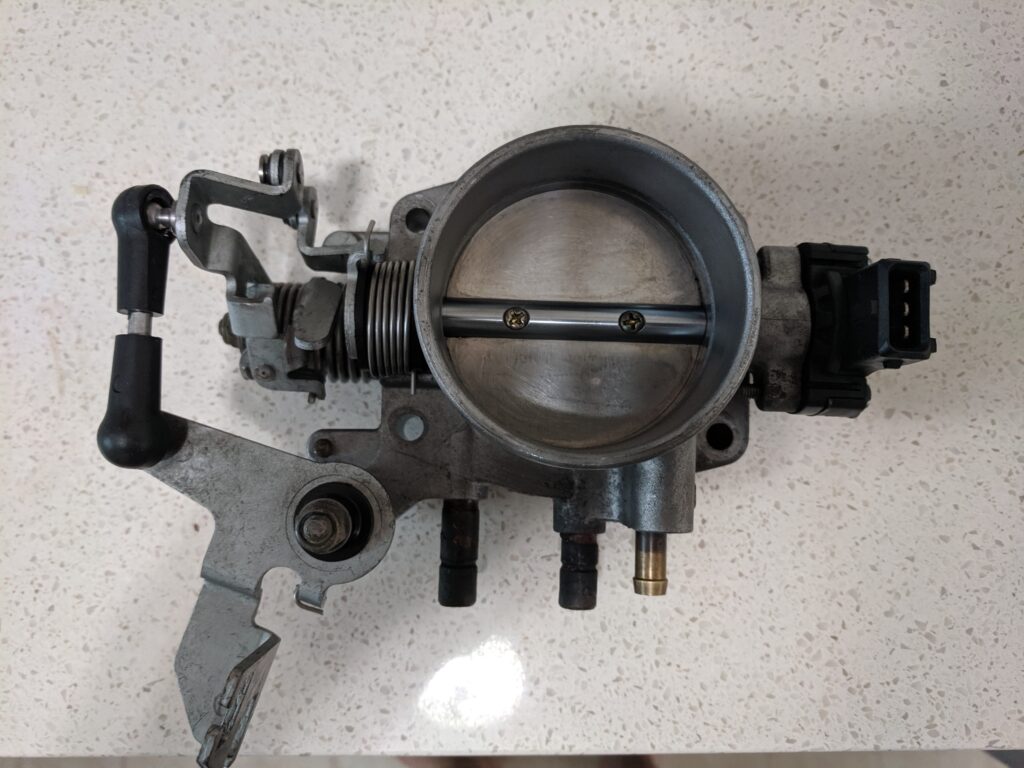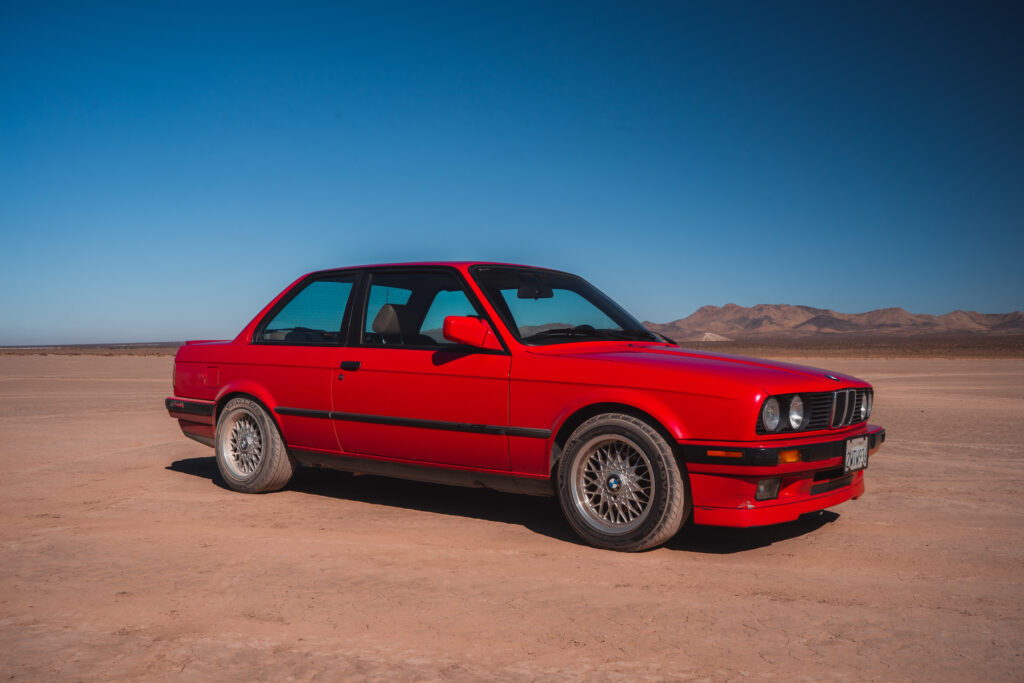Playing by the Golden State smog rules.
Swapping an e30 BMW 3 Series with an e36 (or e34) 24-valve engine is old news at this point. It’s been done time and time again, and everything you need to know about the general installation is plastered all over the internet and likely carved into stone. So if you’re hoping to be unique and original–get in line with the thousands of other e30 owners with the same textbook engine swap. However, residents of California often have to jump through a variety of hoops to get their vehicles smogged for registration renewal. So what makes a California swap any different?
We’ve all heard about California’s strict emissions standards, along with the roadside CHP “inspections” hunting down illegally modified vehicles. The good news though is you don’t have to wait for your GTA 5 wanted stars to disappear in order to drive your 24v swapped e30 on California’s roads. Despite the strict standards, you can still have an engine swapped e30 in California, all while remaining emissions compliant. In this article, we’ll go over the specifics of what it takes to get your OBD1 M50 or S50 swapped e30 California legal.
What’s Your Plan with Your 24v Swap?
If you’re reading this, our guess is the 24v swap is underway or has already been completed. However, if you’re on the fence or still debating which motor to choose, we’ll be the first to say that the 2.5-liter M50 is probably not worth the time and effort these days if you want increased performance over an M20 325i engine.
Unless you got a smoking deal on the parts, or simply have stuff laying around, the total cost of an M50 vs an S50 conversion will be similar aside from the initial price premium of the S50 engine itself. That being said, an M50 swap is still a great engine with better serviceability and fuel economy over an M20 (and reliability over an e30 M42), but if you want to build a weekend warrior or fun street machine, bite the bullet and go for the S50. Now let’s deep dive into what the B.A.R. (Bureau of Automotive Repair) referee inspection process will entail.
Your E30 M50 & S50 OBD1 BAR Swap Checklist
Alright, it’s time to get into the nitty gritty of what separates a California BAR legal engine swap from a standard swap into your e30 BMW.
- Engine Choice
- ECU & Wiring
- Evap System
- Exhaust Manifolds
- Exhaust System Routing with Catalytic Converters
The Engine
Stock, stock, and did we mention stock? If you want to pass the B.A.R. inspection in California, save yourself a lot of headaches and commit to a stock engine configuration. For the M50 and S50 engines, that means everything from the mass airflow meter through the catalytic converters must be stock BMW or C.A.R.B. approved parts. Since the factory engine was designed to pass California emissions, leave it the way it was. Essentially the engine should look as though it was plucked from a running e36 or e34 and simply placed into the e30’s engine bay. No need to go overboard reengineering hoses and vacuum systems, that’s what they paid the big brains in Munich to do in the first place.

If you have a very late production e30, such as a 1992 or 1993 convertible, you have to pay more attention to your donor engine. The rules state that an engine swap must be from the same year or newer. Translated into layman’s terms, if you have a 1992 or 1993 model year e30, you cannot install an older engine (such as a 1991 model M50) into your vehicle. For 1991 and older model year e30s, this isn’t an issue as any of the M/S50 24v engines will be the same age or newer.
When it comes to internal engine components, sure you can try aftermarket cams or custom compression ratio pistons, but there’s no guaranteeing it’ll pass the sniffer, so why risk it? And if you were hoping to sneak that big-boi snail by the inspector—sorry not going to happen. A Dinan supercharger with a CARB sticker on the other hand is fair game, but we’ll get to that later in this guide.
ECU & Wiring
To get the 24-valve engine to run in an e30, you’ll use the M50 or S50 wiring harness and adapt it to your specific vehicle’s wiring pinout. In terms of the referee inspection, the ECU or (DME as it’s sometimes referred to) needs to match the engine in the car. The 2.5-liter M50 non-Vanos engine (1991-1992) uses the Bosch ECU that ends in “402” or “403”, while the M50 Vanos engines (1993-1995) use the “413” ECU. S50 3.0-liter engines from the 1995 M3 use the “506” ECU. And if you’re not sure what car/engine your ECU came from, you can run the VIN number on the case to identify it as well.
While it’s popular to use the “red label” 413 ECU with a custom chip in an S50 engine application (often to avoid EWS immobilizer issues, but EWS delete chips are available for “silver label” ECUs), the referee needs to run the VIN off the ECU to help verify the engine. Additionally, it makes the referee’s job easier if the ECU is left hanging in the glovebox, that way they can read the ECU information right away.

Another small, but critical detail is your check engine light. Your cluster CEL must be functional, or the check engine light will have to be retrofitted if your car did not have one stock (such as the 325e and M3 models). While your check engine light should not remain on while the vehicle is running (meaning there is a fault code), it does need to illuminate with the rest of the cluster lights when the electrical system is turned on before starting the engine (position 2 of the ignition switch).
Evaporative System
For one reason or another, a lot of folks completely ignore the charcoal canister and EVAP valve. The irony is it’s very simple to do. The 24-valve engine harness has a connector that plugs right into the e30’s purge valve because it’s a shared part between the e30, e34, and e36.
The purge valve has two fittings on it: one that stems from the charcoal e30’s canister, while the fitting on the other end will now feed into the M50/S50 throttle body port with a bit of fuel hose (it will be the smaller port that feeds into the bore of the throttle body itself—the other 2 are for the coolant warmup). That’s it! No trickery or tomfoolery. And anyone that can’t be bothered to connect the EVAP system is just plain lazy–which is probably one of the many reasons why their car doesn’t have a B.A.R. sticker.

On the topic of the EVAP system, make sure your fuel cap is in good condition and seals well, as it will be checked during the inspection process.
Exhaust Manifolds
This one is pretty simple: use the factory cast iron exhaust manifolds found on the e36 M50 or S50 engines. While the e34 exhaust manifolds may work, they are a little different in terms of fitment and can pose issues with fitting the rest of the exhaust system.
Exhaust System
This is a highly debated topic when it comes to passing the B.A.R. inspection, and for good reason. This is up to the referee’s interpretation of the rule book. Some referees require the complete and unmodified donor engine exhaust system to be fitted, while others are more lenient with modifications to get the exhaust system fitted into the e30 chassis. To make your life easier, it’s worth calling or setting up a preliminary appointment with the referee at your local B.A.R. test station to discuss exactly how you should fit your 24v exhaust system. That being said, there are a few ways to go about fitting the e30 with the necessary catalytic converters.
Option 1 – Stock & Unmodified:
This setup involves bolting on the factory BMW e36 midsection with the factory catalytic converter onto the e30 with the M50 or S50 engine. Sounds easy right? Not so fast. Getting the unmodified midsection to fit the e30 requires a few things.

First is the use of the low profile “Treehouse eyeball” offset style control arm brackets, because the 24v downpipes will not clear the factory rubber control arm bushing brackets.
The second item you’ll run into with the unmodified midsection is the ability to clear the e30’s front subframe. You can try to dent or clearance the subframe where the downpipe makes contact, but it won’t be pretty. It may even be required to shim the motor mounts to gain additional clearance.
Lastly, the unmodified e36 midsection hangs too low. If your car is lowered even with a mild set of H&R OE Sport springs, get ready to scrape on bumps and driveway inclines!
Option 2 – Modifying Factory Midsection:
If allowed by the referee, this option is fairly straightforward aside from a bit of fabrication by an exhaust shop. Modifying the factory e36 midsection entails modifying the downpipes for better clearance within the e30 chassis. Otherwise the rest of the factory midsection remains intact, allowing you to still use the factory e36 oxygen sensor location, catalytic converters, and resonators.
Option 3 – Custom Exhaust:
This approach is arguably the cleanest in terms of fitment (assuming your wallet and exhaust shop are up to the task), but only if the referee says it’s OK. When making a custom California legal exhaust system for the 24v swap it has to match the e36’s factory exhaust routing in the following order:
- Dual downpipes that run off the exhaust manifolds (1 from each manifold)
- A Y-merge into a single pipe
- A single oxygen sensor port located within the single pipe section
- A Y-split back into 2 pipes that feed into dual CARB legal e36 325 and/or 1995 M3 catalytic converters (Walker and Magnaflow are popular brands for aftermarket cats, and can also be used as replacements for a stock midsection). Make sure the cat CARB part numbers face downwards so they can be easily read.
- The exhaust setup after the dual catalytic converters is completely up to you. To prevent drone and a raspy exhaust note, it’s advised to fit a resonator (or 2) before the exhaust enters the muffler of your choice. It should be noted that the post-cat section of the exhaust is fair game and can be a dual or single pipe setup (or even 6 pipes if you really want to make the e30 version of the Cannonball Run Countach).
The Inspection
So you’ve called the referee and set up an appointment to have your car inspected. What can you expect?
Each referee will have their own process for inspecting your vehicle, but your visit should include the following:
- Reviewing paperwork (vehicle registration, donor engine receipts, vehicle diagrams, etc.)
*As of January 2023, pre-inspection virtual appointment is now done to verify details of the swap prior to an in-person inspection, as outlined in this video. - Inspecting the engine swap itself and making sure all components and systems match and function as they would in the donor vehicle (engine components, emissions equipment, catalytic converters, ECU numbers, etc.)
- If all passes the visual test, the referee will move onto testing the emissions (same as a conventional smog test, but the vehicle will now be smog tested against the donor engine standards)
- If you pass the emissions test, you will pay around 10 dollars and receive a sticker that is placed on the chassis. This BAR sticker will have the vehicle and engine swap information and can be scanned by a regular smog station the next time you’re due for a smog check.
E30 California BAR Swap FAQ
Q: I have an M52 or S52 engine. Can I convert it to OBD1 and take it to the referee?
A: No, the M52 and S52 are OBD2 engines and have to retain the OBD2 functionality and emissions equipment to be certified as a California legal swap. Do not try to pull a fast one on the referee. It’s their job to be thorough with the engine swap inspection.
Q: Do I need a CARB legal intake for an OBD1 swap?
A: No, you can use any air filter of your choosing. An e30 M20 airbox can be adapted to work with the stock e34/e36 MAF for an OEM-like appearance, but it is not a requirement. A cone filter setup is perfectly acceptable for an OBD1 24v swap. If your e30 does not have ABS (such as early model e30s), you may be able to use the factory e36 airbox.
Q: What performance modifications can I perform on my M50/S50 swapped e30 and still pass the referee process?
A: CARB legal upgrades designed for the donor engine are acceptable provided they have not been modified or tampered with. For an e30 OBD1 24v swap there are a few CARB legal upgrades that should not affect your ability to pass the referee inspection (and more importantly a smog test!). These include:
- Dinan performance chip (tunes are specific for M50 or S50 applications)
- Dinan Supercharger System for e36/e34/Z3 (must be sourced used as its NLA from Dinan)
- Turner Motorsport Shorty Headers
Q: How can I prepare for a vehicle referee inspection?
A: Here are some pointers to help prepare for the inspection process:
- Start your engine swap right after your biennial smog test has been passed, giving you up to 2 years to complete your swap and make it CA legal.
- Provide paperwork such as receipts for CA legal catalytic converters, bill of sale for the donor engine proving it was not stolen, factory diagrams, or anything else you think may help the referee with their inspection.
- Don’t expect to pass the first time. It’s likely the referee will spend a fair amount of time inspecting the vehicle, especially upon the initial visit. They may flag items that need to be corrected, or the vehicle simply may not pass the emissions portions of the test. Either way, plan on making a few visits to the BAR station.
- Make your swap look as clean as possible. The closer it looks to the factory fit and finish, the referee will have less of a reason to raise an eyebrow. This is where fitting the factory engine covers and keeping the wiring tidy pay off.
- Be polite and have a positive attitude. The referee has the final say if your car passes inspection, so make life easy and be cooperative. Believe it or not, they DO want you to pass, and it’s their job to guide you in the right direction. Treat this like a job interview and make a good impression.
Q: Why should I bother with the BAR process? Can’t I just register my car out of state instead?
A: While it’s possible to go this route, it’s not recommended and only a matter of time before law enforcement notices that your out-of-state registered vehicle is no longer “visiting” (especially if you have a CA driver’s license) and you’ll be required to register the vehicle in California. Chances are a standard smog shop will notice the engine doesn’t match the chassis and you will likely be sent to the referee as a result.
Q: Are there other advantages to getting my car BAR’d?
A: Besides the obvious smog and registration requirements, an e30 with a BAR sticker is often more desirable and valuable should you choose to sell the car. With such a large population, California is a big marketplace for automobiles in general. Since transfer of ownership requires a smog check for most 1976 and newer vehicles, a BAR legal swap makes the process no different than registering an unmodified car.
Q: Does making a 24v swap BAR legal cost more?
A: The only area where you may spend extra money over a generic 24v swap is the exhaust system. California legal cats typically cost more than 49-state equivalents, but the rest of the components (exhaust manifolds, EVAP equipment) you most likely will already have received with your donor engine, is already installed on your e30, or will not differ from non-CA legal M50/S50 swaps.
Q: I see performance shops charging $20,000 to perform a BAR legal engine swap. Why does it cost so much?
A: Shops are businesses that have to make money, and their labor adds up along with any parts they have to source. Some e30 owners don’t want to work on their car, or maybe they don’t have the time or space to complete the swap. If you do have the time, space, and are semi-handy with a set of tools, the labor cost savings can be substantial.
Q: Should I just buy a BAR legal swapped car, or is it worth it to build one myself?
A: As the prices of stock e30s and used BMW parts have increased, purchasing a swap car that has already been BAR’d can provide a great value, especially if you don’t have a lot of spare time or simply want a turnkey vehicle. There should also be demand for the vehicle should you choose to sell it down the line.
While the quality of installation can vary, generally BAR legal swaps have to abide by a certain standard to have passed inspection in the first place. Some owners are sentimentally attached to their vehicles though, which is why they end up going through the swap process themselves.
Q: Why would I bother with an OBD1 swap when OBD2 has a lot more options for tuning and diagnostics?
A: The reason for staying OBD1 with a 24v swap is for sake of simplicity/compatibility with the e30 chassis and more lenient emissions testing standards. In order to legalize an OBD2 swap requires jumping through more hoops, such as fitting the secondary air system, OBD2 connector port, providing proof that the DME/ECU is running a stock factory tune, and the intake setup must be CARB approved if not using the factory e36 airbox.
Additionally, OBD2 swaps have stricter testing requirements. OBD2 swaps have monitors within the ECU that must complete readiness checks with the smog computer before commencing the roller test, which can require a variety of mixed driving conditions to properly achieve. Finally, the car will be required to pass the sniffer section with even less tailpipe emissions than an OBD1 24v swapped car. Plenty of people have made their OBD2 swaps BAR legal in California, but it’s more time consuming and challenging if you choose to go this route.
Build It, BAR It, Drive It
Driving and maintaining an e30 these days is a labor of love, but the experience behind the wheel makes the long hours and dollars spent completely worth it to many owners. Living in California also poses its challenges, but sometimes that’s the price to pay for great weather and beautiful scenery. And now that you have all the information from this guide, you too can get your swapped e30 California BAR legal and rightfully earn that “save the whales” license plate!

There you have it folks, no longer does making your OBD1 M50/S50 swapped e30 have to be a mystery shrouded in secrecy. With a little research and planning, you too can have a motor swapped e30 BMW that is not only fun to drive, but also plays by the rules of the law. Not only will you be able to drive your e30 worry-free on California’s roads, but smogging your e30 will be no different from any other car.
*Disclaimer: The information in this guide is for informational purposes only, and does not substitute the advice of a professional mechanic or technician. Information presented in this article is based on data available at time of writing and is subject to change without notice.













